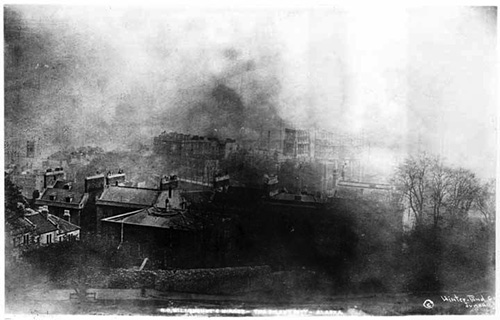
The Silent City of AlaskaWas it hoax? Or a mirage?By DAVE KIFFERMarch 03, 2017
Some people even believed Alaska to be a mysterious, magical land. A land where giant cities appeared, hovering like mirages over the frozen glaciers. This is the story of one such mirage, which came to be called "The Silent City of Alaska." The story begins, as do many in Alaska's early years, with a prospector. R. G. Willoughby's mirage, the Silent City, Alaska.
He spent three years in California and did not strike it rich, so he returned to Missouri in 1857. He didn't stay long and by 1858 he was taking part in the Fraser River Gold Rush in British Columbia. He stayed there and took part in the Cariboo Gold Rush in the 1860s and the Cassiar Gold Rush in the 1870s. He then headed to Juneau where he would allegedly rendezvous with Alaska's Silent City. He was in Juneau in 1880 when it was founded and stayed there for several years, building a home in 1881. He became well known as a photographer and raconteur. The "ghost city," a large collection of buildings that was reported to have be seen hovering over glaciers and ice fields before suddenly disappearing had been reported numerous times over the preceding decade. Willoughby, who also had scientific pretentions and was occasionally known as Professor Willoughby, decided to try to capture the apparitition on film. On July 21, 1888, near Muir Glacier in Glacier Bay, he succeeded. Or so he claimed. As part of his story, Willoughby claimed the mirage appreared between June 20th and July 10th each year. He said it was the "reflection" of a Russian city hundreds of miles away. Soon he was selling hundreds of copies of the photograph of "The Silent City" for 75 cents each in Juneau and elsewhere. The photograph was even mentioned in some of the numerous accounts of Alaskan travelers, as well as books such as the best-selling "The Wonders of Alaska" by Alexander Badlam in 1891. The story was repeated in newspapers across the entire country. Of course, there were skeptics. Although mirages were a common atmospheric phenominun, few mirages were distinct enough to be captured on film and the slightly blurry photo that Willoughby was selling was clearly the image of a modern city with an old stone church building near its center. Within a decade, several writers had identified the Silent City photo as actually depicting Bristol, England. It was rumored that Willoughby had purchased a photographic kit in Canada in 1887 and found an overexposed negative of Bristol in the kit and used it to make the Silent City prints. But even if the photo itself was not genuine, there were still many who claimed to see the mirage over the ice fields. The most notable sighting report was by C.W. Thorton, a member of the first team of climbers to summit Mt. St. Elias, the second highest peak in Alaska in 1897. Climbing with the famed Duke of Abruzzi (who later pioneered the successful route up K2 in the Himalayas), Thornton told Popular Science Monthly that he, and all the members of the St. Elias climbing team, had seen the "The Silent City" and that it was as depicted in the Willoughby photo. "It required no effort of the imagination to liken it to a city," Thorton told the magazine in 1901. "It was so distinct that it required faith to believe that it was not really a city." Two years earlier, Oct. 31, 1889, the New York Times had reported the experience of a traveler, L.B. French, who claimed to have seen the mirage in Glacier Bay. "At about 5 o'clock in the afternoon of an early July day, we suddenly perceived rising above the glacier over in the direction of Mount Fairweather what at first appeared to be a thin misty cloud," French told the Times. "It soon became clearer and we saw a distinct specter city moving toward us. We could plainly see houses, streets and well defined trees, here and there rose tall spires over huge buildings with appeared to be ancient mosques or cathedrals. It was a large city, one that would include at least 100,000 residents. I have seen Milwaukee mirage over Lake Michigan and this city appeared considerably larger than that. It did not look like a modern city - more like an ancient European city. I noticed particularly the immense height of the spires. " French said the "apparition" lasted about 25 minutes and the members of his party were awestruck by it. He said the Native Americans traveling with his group became distressed and ran away. Willoughby died in 1892. Before he passed away he told friends he had sold the Silent City negative to a San Francisco photographer for $500. But when others tried to locate the photographer or the negative they were unsuccessful. Only the prints, which were produced by Winter and Pond in Juneau, remain in the Alaska State Archives as "evidence" of "The Silent City of Alaska."
Contact Dave at dave@sitnews.us Dave Kiffer ©2017
Publish A Letter in SitNews Read Letters/Opinions
|
||
